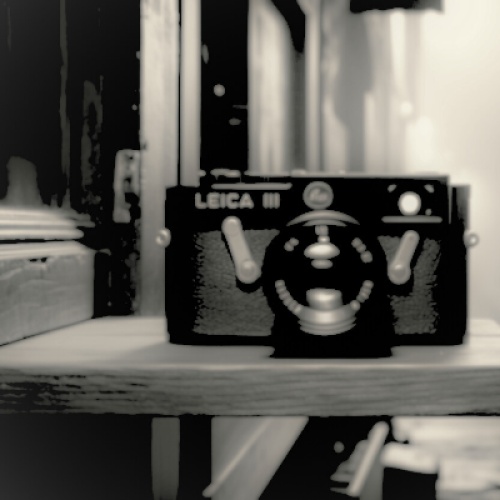Part I: Shutter Dream
The smell of developer fluid had long since sunk into the drywall. Elliot Harper sat in the darkroom, the red light above his head pulsing faintly, like the heartbeat of something no longer alive. On the line before him, a photograph dangled - a blurred image of a 1940s kitchen, a crying woman, a cigarette burning in a man's hand. And reflected in the oven door, as clear as if it were taken today: his own face.
He didn't remember taking it.
His fingers hovered near his notebook, scrawled with half-legible thoughts:
> "Third instance of reflection. Nonlinear presence confirmed.
Memory or manipulation?"
Behind him, the camera waited.
An antique Leica III. No power source. No digital interface. Just brass, glass, and silence. It looked like something a war correspondent might have worn around his neck in the trenches - but in Elliot's hands, it felt alive. Watching.
He had found it - or maybe it had found him - three days ago in a shop that didn't exist on any street he could now recall. What he remembered was the fog, thick and oil-slick black, the way it swallowed Raven Hollow's alleyways like a tide rolling backward in time. And then: the storefront.
Whitaker's Curiosities.
"Everything has a memory."
Inside: antiques that whispered with history. Clockwork angels, shattered mirrors, a dusty globe still spinning. At the back stood the shopkeeper - tall, silver-eyed, with skin like vellum stretched too tight.
"You've come back," he'd said softly. "The camera remembers you."
Elliot had denied it. But his hands, unthinking, had already lifted the Leica from the shelf. The old man, Whitaker, gave him a roll of black-and-white film without asking for payment.
"For the first exposures," he murmured. "To remind you."
---
That night, Elliot developed the first roll.
None of the images matched what he'd photographed. Instead of alleyways and street signs, he saw:
A man dying in a trench, clutching a bloodied cross.
A woman screaming in an empty ballroom.
A child floating face-down in a bathtub.
And in each image, without fail, was a distant man in a fedora, blurred just enough to escape identity - yet present enough to feel intentional.
After the third photo, Elliot stopped sleeping.
After the fifth, the hallucinations began.
---
On the sixth night, he returned to the Leica. He stared at it like it was an altar. Then, with a tremble in his fingers, he opened the locked box under his desk - a box he hadn't touched in a decade.
Inside were the remnants of his worst night:
His sister Natalie's school ID, half-melted.
A clipping from the local paper - "HOUSE FIRE KILLS TEEN GIRL; BROTHER SURVIVES".
A piece of scorched, undeveloped film.
He had no real memory of the fire. Only flashes: a scream, the sound of glass shattering, orange on the walls. He told himself the rest had been blocked out by trauma. That the therapist was right.
But he had always feared the truth was worse: that he hadn't forgotten it.
He had rewritten it.
---
He loaded the burnt film into the Leica. The click of the shutter sounded like the closing of a vault.
In the red-dark of the darkroom, the photo emerged:
The house.
Not the ruin it had become - but whole again, washed in soft lamplight.
In the window stood Natalie, no older than fifteen, smiling. Behind her: movement. Shadows. Him?
Elliot stared. He blinked - and in a blink, the image changed.
Natalie was no longer smiling. She was reaching. Mouth open in a scream. The living room behind her was burning. Flames licked the curtains.
And he saw himself - not a boy, but a man - watching through the window. Doing nothing.
"No," Elliot whispered. "That's not how it happened."
But his memory was unraveling like old film stock:
He remembered pounding on the door.
He remembered locking it.
He remembered running into the fire.
He remembered running away.
Which version was real?
---
He took the photo and went to the mirror.
The man who stared back wore his face, but his eyes didn't match.
He lifted the Leica again and clicked the shutter at his reflection.
The photo that developed showed a room tiled in black, windowless. In it sat Elliot - tied to a chair, smiling faintly.
A note was scrawled on the wall behind him, barely legible in the grain of the film:
"She remembers.
Do you?"
---
He returned to Whitaker's shop. Or tried.
The alley was gone. The building was gone.
In its place stood a chain pharmacy and a dry cleaner.
But when he looked through the camera lens - there it was.
Whitaker's Curiosities.
Still waiting.
Still watching.
The smell of developer fluid had long since sunk into the drywall. Elliot Harper sat in the darkroom, the red light above his head pulsing faintly, like the heartbeat of something no longer alive. On the line before him, a photograph dangled - a blurred image of a 1940s kitchen, a crying woman, a cigarette burning in a man's hand. And reflected in the oven door, as clear as if it were taken today: his own face.
He didn't remember taking it.
His fingers hovered near his notebook, scrawled with half-legible thoughts:
> "Third instance of reflection. Nonlinear presence confirmed.
Memory or manipulation?"
Behind him, the camera waited.
An antique Leica III. No power source. No digital interface. Just brass, glass, and silence. It looked like something a war correspondent might have worn around his neck in the trenches - but in Elliot's hands, it felt alive. Watching.
He had found it - or maybe it had found him - three days ago in a shop that didn't exist on any street he could now recall. What he remembered was the fog, thick and oil-slick black, the way it swallowed Raven Hollow's alleyways like a tide rolling backward in time. And then: the storefront.
Whitaker's Curiosities.
"Everything has a memory."
Inside: antiques that whispered with history. Clockwork angels, shattered mirrors, a dusty globe still spinning. At the back stood the shopkeeper - tall, silver-eyed, with skin like vellum stretched too tight.
"You've come back," he'd said softly. "The camera remembers you."
Elliot had denied it. But his hands, unthinking, had already lifted the Leica from the shelf. The old man, Whitaker, gave him a roll of black-and-white film without asking for payment.
"For the first exposures," he murmured. "To remind you."
---
That night, Elliot developed the first roll.
None of the images matched what he'd photographed. Instead of alleyways and street signs, he saw:
A man dying in a trench, clutching a bloodied cross.
A woman screaming in an empty ballroom.
A child floating face-down in a bathtub.
And in each image, without fail, was a distant man in a fedora, blurred just enough to escape identity - yet present enough to feel intentional.
After the third photo, Elliot stopped sleeping.
After the fifth, the hallucinations began.
---
On the sixth night, he returned to the Leica. He stared at it like it was an altar. Then, with a tremble in his fingers, he opened the locked box under his desk - a box he hadn't touched in a decade.
Inside were the remnants of his worst night:
His sister Natalie's school ID, half-melted.
A clipping from the local paper - "HOUSE FIRE KILLS TEEN GIRL; BROTHER SURVIVES".
A piece of scorched, undeveloped film.
He had no real memory of the fire. Only flashes: a scream, the sound of glass shattering, orange on the walls. He told himself the rest had been blocked out by trauma. That the therapist was right.
But he had always feared the truth was worse: that he hadn't forgotten it.
He had rewritten it.
---
He loaded the burnt film into the Leica. The click of the shutter sounded like the closing of a vault.
In the red-dark of the darkroom, the photo emerged:
The house.
Not the ruin it had become - but whole again, washed in soft lamplight.
In the window stood Natalie, no older than fifteen, smiling. Behind her: movement. Shadows. Him?
Elliot stared. He blinked - and in a blink, the image changed.
Natalie was no longer smiling. She was reaching. Mouth open in a scream. The living room behind her was burning. Flames licked the curtains.
And he saw himself - not a boy, but a man - watching through the window. Doing nothing.
"No," Elliot whispered. "That's not how it happened."
But his memory was unraveling like old film stock:
He remembered pounding on the door.
He remembered locking it.
He remembered running into the fire.
He remembered running away.
Which version was real?
---
He took the photo and went to the mirror.
The man who stared back wore his face, but his eyes didn't match.
He lifted the Leica again and clicked the shutter at his reflection.
The photo that developed showed a room tiled in black, windowless. In it sat Elliot - tied to a chair, smiling faintly.
A note was scrawled on the wall behind him, barely legible in the grain of the film:
"She remembers.
Do you?"
---
He returned to Whitaker's shop. Or tried.
The alley was gone. The building was gone.
In its place stood a chain pharmacy and a dry cleaner.
But when he looked through the camera lens - there it was.
Whitaker's Curiosities.
Still waiting.
Still watching.





